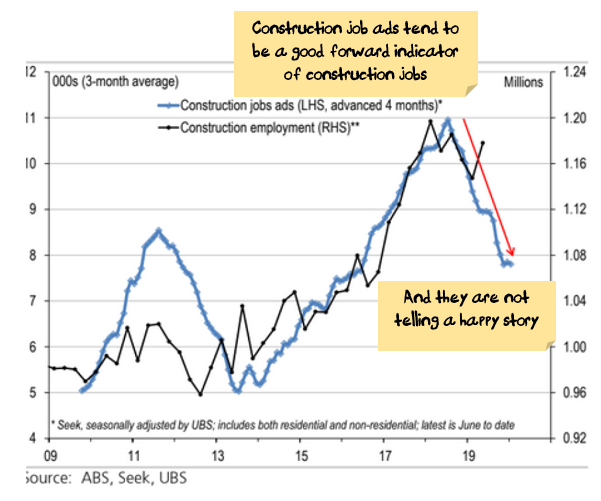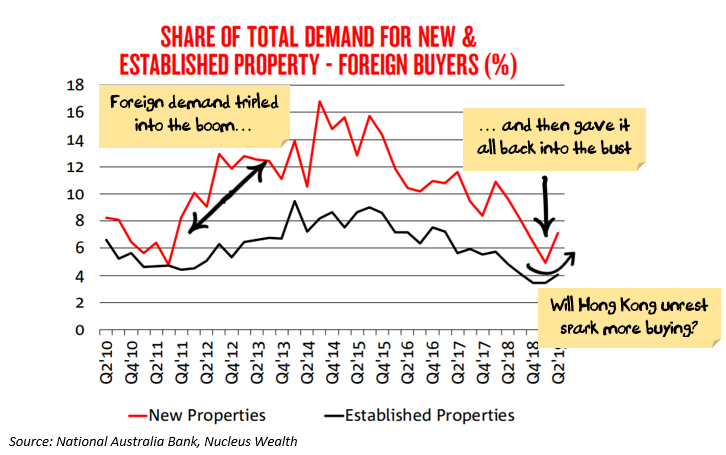Most superannuation funds lost money in August on the back of the Australian stock market, falling around 2%. Our tactical funds all bucked the trend to increase in August on the back of our overweight bonds and heavily underweight Australian stocks holdings:

In our portfolios, we are positioned for adverse outcomes, which means that we tend to lag the market on strong up months and then make back the returns in weaker months. Assets are priced for perfection, and we are expecting conditions to be far from perfect:
- corporate earnings are clearly weakening globally,
- inflation is almost nonexistent,
- central banks know that they are out of ammunition and are begging governments to borrow,
- largely governments are ignoring them.
The one major exception is the US, although borrowing to give companies and the wealthiest 1% a significant tax cut is not what central bankers would have preferred.
This leaves most of the world relying on US growth to lift exports and demand enough to offset their own government’s failure to act. And with US growth now slowing after the sugar hit of tax cuts last year a range of countries, particularly in Europe, are being exposed as having no actual growth plan other than hope that someone else will do the heavy lifting.
Market Ructions
There have been four events in the past few weeks that are cause for concern:
- Quant Quake 2.0: Over the first ten days of September, Momentum stocks traded down around 10% while Value stocks traded up about 6% – a massive intraday change on a single day delivering most of the change. Meanwhile, the market itself barely moved.
- Repo Interest Rate Spike: A week after Quant Quake 2.0, overnight repo rates spiked to 10%, defying the US Federal Reserve which spent days pumping additional liquidity to bring rates back in line.
- General stock market volatility in August saw eleven days where markets moved more than 1%.
- Drone/Cruise missile strike: A missile strike on critical oil infrastructure in Saudi Arabia knocked out a considerable amount of oil production.
The common theme of the ructions is uncertainty.
The Quant Quake 2.0 is reminiscent of Quant problems in 2008 just before a significant market downturn:
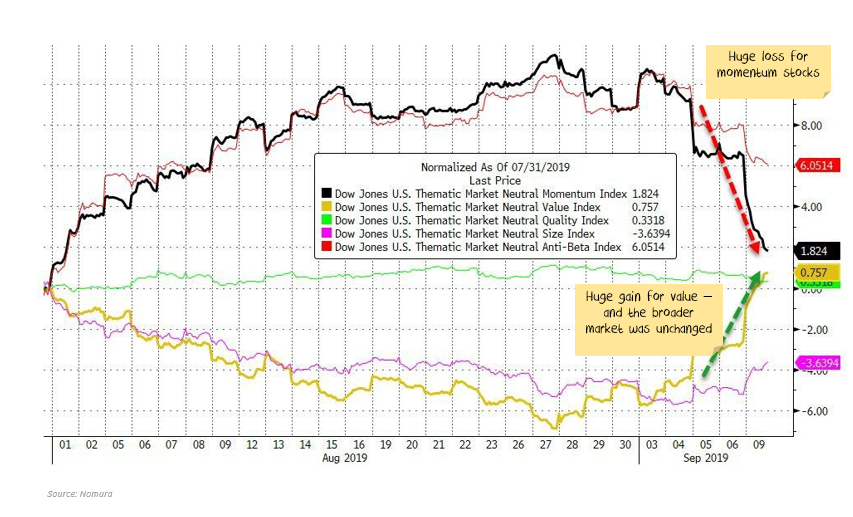
This may be a re-run. Post the 2008 Quant Quake 1.0, quantitative strategies became far less popular. Quantitative approaches had a renaissance over the past five years – the ructions may be a sign the momentum trade has again become “too crowded”.
The lack of an explanation is as concerning as it was in 2008. There are plenty of competing theories as to the cause. Momentum is not a strategy Nucleus follows – it is a very high turnover strategy, prone to sudden reversals as we saw earlier this month.
The Repo market had a similar dislocation:
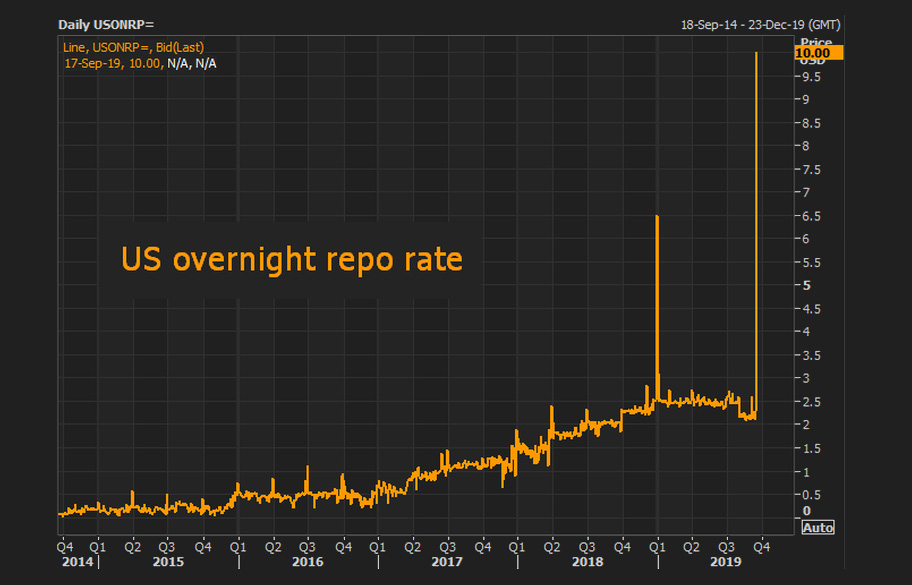
I won’t go into the details as they are quite technical, the overarching narrative is some critical parts of the “plumbing” of financial markets are blocked up and defying the US Federal Reserve’s attempts to unblock them. And while the repo market issues were sudden, problems in other parts of the plumbing (e.g. interest rate on excess reserves) have been seeing issues for a year or so now.
Once again there are a number of competing theories as to the reason – none of which are broadly accepted as the reason. Uncertainty is high.
Next, we saw considerable volatility in stock markets:
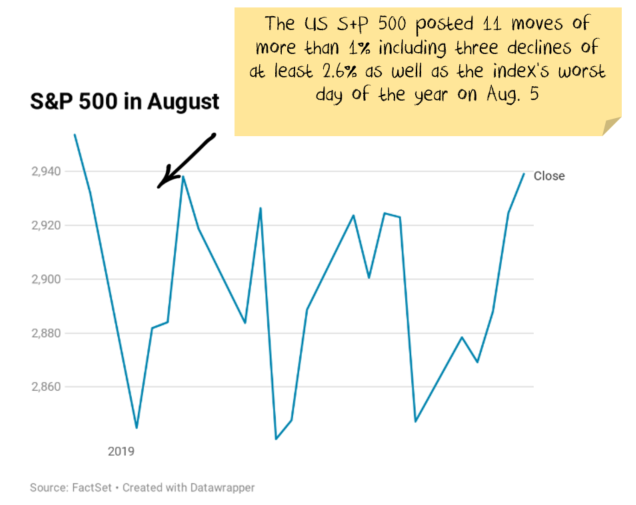
Some of this “choppy” trading is affected the momentum issues above. Sudden movements in opposite directions often cause that strategy to lose money.
The larger issue is that volatility often indicates uncertainty and before significant downward changes in stock prices, we often see an increase in volatility like this.
Finally, we saw drone/missile strikes on Saudi Arabia take out significant oil infrastructure:
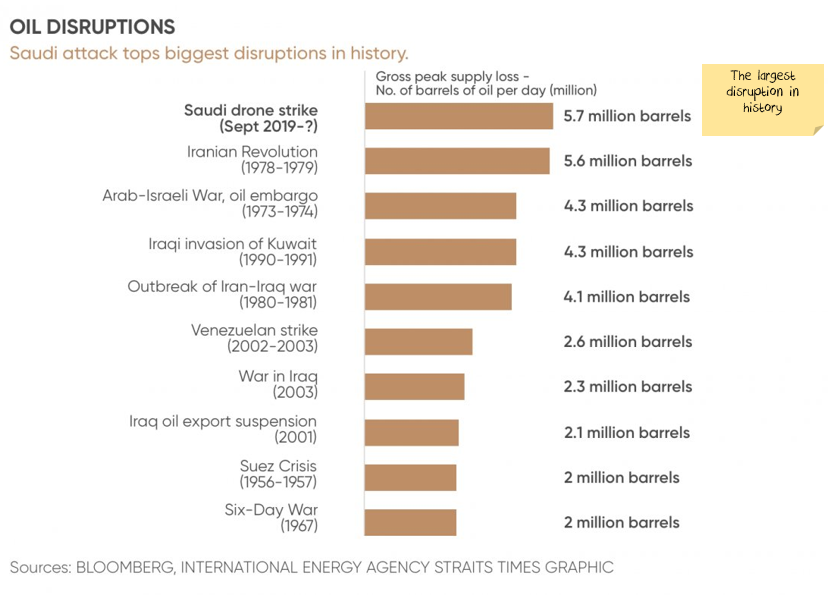
There is uncertainty over how direct Iran’s involvement was and whether it will spark war in the Middle East. Higher oil prices will also act as a drag on the economy. As the higher oil prices are likely temporary, they are less likely to spark additional capital expenditure.
On their own, none of the four factors represents an imminent threat to investor portfolios. But, together, there is an indication there are issues with the global economy and financial system. Given:
- There are very high levels of corporate debt
- Banks (particularly in Europe) are not very profitable and still over geared
- Consumer spending is weak globally
- Monetary policy is in uncharted territory in many countries
the margin for error has shrunk – a dislocation in one area could see contagious effects in other markets.
For example, If we see ructions causing a large company or bank to fail, then corporate bond yields would likely spike higher. Central banks have spent ten years trying to get interest rates lower (to spark corporate investment), and a spike in yields would undo most of this. Then there would be flow-on effects with other corporates dealing with higher interest rates and more defaults.
I’m not saying this is imminent, just that the market is vulnerable. There aren’t signs of fire yet, but there is enough smoke to be wary.
Bond Outlook
Much of our performance over the last six months was a successful bond investment, and most of the bond upside has already been achieved. We have switched significantly into cash which leaves us at risk of underperforming if markets rise sharply. But this is not our expectation.
Our portfolios are still slightly overweight bonds, and we own more of the longer-term series. This makes our bond holdings a little more sensitive to movements in bond prices.
We are looking at Australian 10-year bond rates as having a band between 0.9% and 1.5%. We are buyers at closer to 1.5%, taking profits on our holdings at closer to 1%. All else being equal, a significant rise in bond yields would see us using cash to buy more bonds. A fall would see us selling more.
Australian Outlook
The economic plan in Australia is aiming for a short term fillip that will be enough to keep growth ticking over until some form of economic luck strikes. Maybe more Brazilian mining disasters to spike the iron ore price higher, or China to unleash another massive capex stimulus program, or more earthquakes to shut down nuclear reactors in Japan to send coal and gas prices soaring.
At the moment Australian government’s fillip plan is to try to re-ignite the housing boom by convincing the world’s most indebted consumer to borrow more – a short term win for the Australian economy at the cost of longer-term growth.
This has a number of obvious pitfalls, but we need to acknowledge it may be successful. Economic luck has been on Australia’s side for the last 15 years and so maybe Australia will get lucky again.
The danger is that Australia doesn’t get lucky, or more concerning is unlucky.
Ignoring outside factors (for the moment), there are three key factors we are following that will tell us whether the government’s fillip is going to work:
Factor 1: Australian Credit growth:
The Royal Commission into banking reversed the credit boom and was enough to see house prices down around 10%, even while most other factors affecting house prices were still positive.
If I am too bearish (particularly in the short term) and the Morrison government manage to get the already over-levered Australian households to take on more debt, this is where you will see the effects first.
On the regulatory front, the Westpac v ASIC responsible lending initial court case win for Westpac is a boost for easy lending conditions. ASIC is taking the case to the Federal court which will probably limit the upside.
Factor 2: Unemployment
There is not enough space here to go into the detailed links between house prices and unemployment. Indicatively, during the 2012 to 2017 housing boom years, the Perth market faced largely the same factors as Sydney/Melbourne except for (a) slightly weaker population growth and (b) rising unemployment. And Perth property prices fell more than 10% while the rest of Australia boomed.
We are expecting considerable job losses in the construction sector.
Source: ABS, Seek, UBS
Add to this scenario job losses from Victorian and NSW state government austerity.
Any global shock (trade wars, recessions, debt crises) is likely to be transmitted to the housing market through higher unemployment.
Factor 3: Foreign Buyers
Foreign demand was key to both the boom and the bust:
China cracking down on its capital account and deteriorating relations between Australia and China suggests foreign investment will remain low.
The key upside question is whether Hong Kong unrest sees increased demand in Australian property.
Asset Allocation
The real question for asset allocation is what to do in the meantime. The current government has at least three years in power, plenty of scope to increase government debt to support the housing sector in novel ways and no compunctions about trying to convince Australian consumers to borrow even more.
Blowing the property bubble meaningfully larger is probably beyond the Australian government, but arresting the fall and boosting prices seems likely.
The risk is some sort of global shock or broader economic downturn. Australia has already “broken glass in case of emergency” to prop up the housing market and many of the policies that could be employed in a crisis have already been employed. Meaning that in the event of a genuine crisis the downside is going to be more pronounced.
Which leaves a measure of conflict in asset allocation. Do you try to ride a short term stabilisation in the Australian economy and run the risk that any global crisis is likely to be devastating? Valuations have made part of the decision with the Australian market looking increasingly expensive.
So where does an asset allocator turn? In 2018 with a slowing Australian economy, stagnant wage growth and ten-year government bond yields of 2.8% we felt being overweight bonds was an easy decision (investors make money on bonds when yields fall).
At the time we were one of the only voices expecting rate cuts in Australia. Now the first two rate cuts have occurred and further cuts are a consensus opinion.
While we were expecting Australian ten-year bond yields to fall to these levels (1.1%), we weren’t expecting them to fall so quickly. The last 8 months have been dramatic.
Keep in mind that the Reserve Bank of Australia has an inflation target of 2-3%. At current yields, the bond market is suggesting that it will not meet that mandate for the next ten years. Which, in the context of the European and Japanese examples, anemic wage growth, world-leading private indebtedness and an overvalued housing market, is probably a reasonable assumption – unless something changes.
We are of the view that stagnant growth is going to be on the menu until we see governments spending money. And probably “helicopter” money. Given the current state of economics, that will probably take some sort of reasonably large economic crisis. Until then, we expect more of the same, slow growth and a grind lower.
The low yields present another asset allocation quandary. I was hoping that by this stage we would have seen equity prices that were more reasonable, giving us the opportunity to switch out of our bonds and into equities. But equities are looking expensive. Not irrationally expensive, but certainly more expensive than we would have thought given the uncertain and low growth outlook. So we are now holding lots of cash, looking for the right opportunity.
August Performance
Our tactical portfolios outperformed significantly in August, aided by a falling Australian dollar and increasing bond yields. As we discussed last month, our portfolios are defensive and so will perform better than the average superannuation fund when stock markets are weak. We are comfortable with the view that the defensive position is warranted given that downside protection is more important at this point in the cycle than chasing stock markets higher:
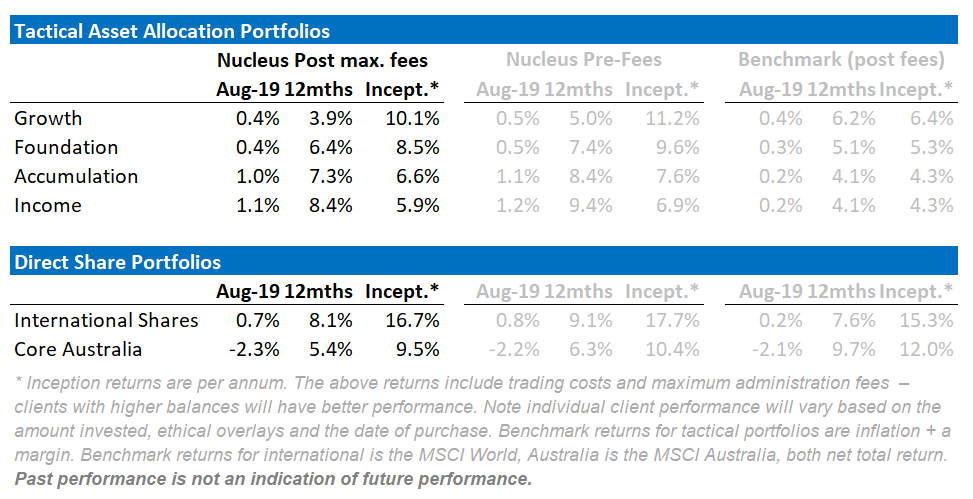
Despite the volatility our portfolio performed relatively well, outperforming the MSCI World. The largest performance detractors were companies reporting poor results or weak outlooks. The defensive drugmakers were the best performer. During the month we took a more defensive stance by taking profits on Tyson Foods and Micron while increasing defensive property and infrastructure stocks. Specifically, we took positions in Simons Property Group (a US shopping centre group not unlike our Westfields), Canada National Railways, Comfortdegro (a Singaporean diversified transportation services group) and EDP /ENGIE (two European energy suppliers with a Green focus).
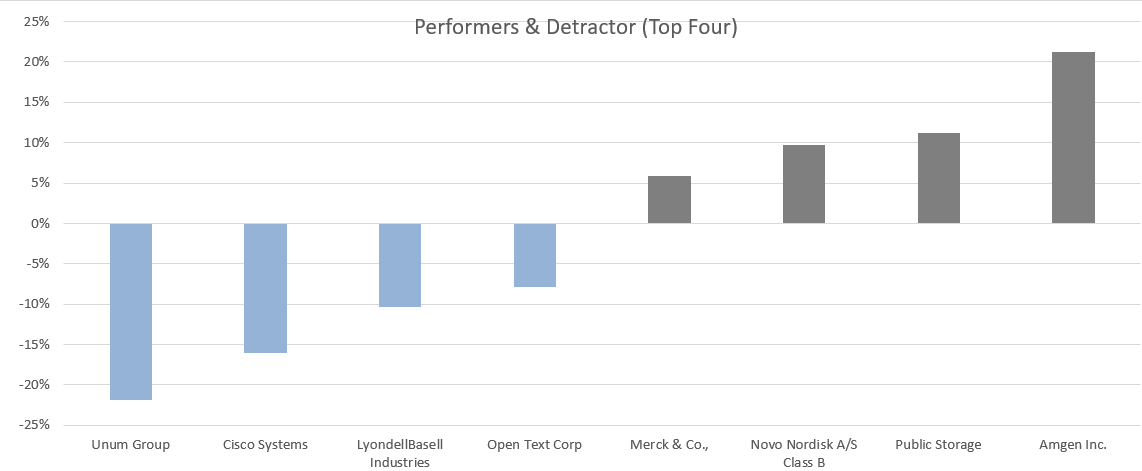
Outlook
Australian shares are still considerably more expensive than most international comparisons with poorer growth expected. We retain large cash and bond balances to hedge against volatility and in the expectation that capital protection will be important during 2019.
Our key focus is on:
- Chinese growth, gauging the extent of the slow down and the policy response to the trade war
- Trying to work out how sustainable the effect of the Australian election will be on house prices
- Gauging the damage that a Boris Johnson led hard Brexit might cause
——————————————-
Damien Klassen is Head of Investments at the Macrobusiness Fund, which is powered by Nucleus Wealth.
The information on this blog contains general information and does not take into account your personal objectives, financial situation or needs. Past performance is not an indication of future performance. Damien Klassen is an authorised representative of Nucleus Wealth Management, a Corporate Authorised Representative of Nucleus Advice Pty Ltd – AFSL 515796.

